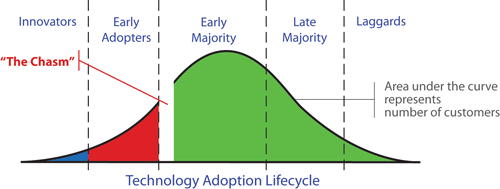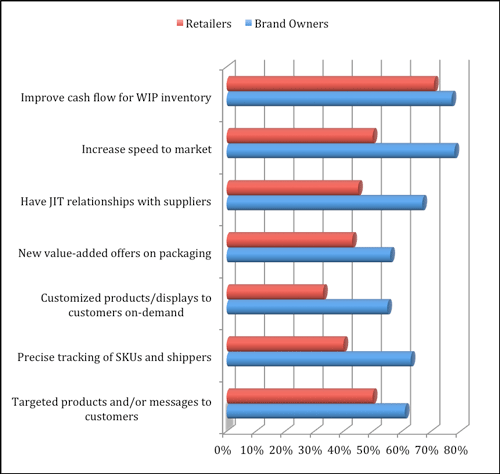With all the news chatter around digital printing for packaging coming out of Print 13 and Label Expo this fall I thought it appropriate to bring the WTTL&P readership some insights we have on the topic. This and subsequent articles will be comprised of excerpts from a 155 page report we have published titled; Is Digital Printing Part of Your Brand or Operational Strategy? The report is tailored for Brand Owners and their Supply Chain Partners who are seeking information on the use of digital printing for packaging. The report was written in conjunction with Mike Ferrari of Ferrari Innovation Solutions and I feel is ideally suited to this venue.
Edited excerpt from; Is Digital Printing Part of Your Brand or Operational Strategy? Karstedt Partners LLC, 2013
Many analysts forecast a bright future for Digital Printing in the Packaging Market, and while we concur the future does look promising, we see the future evolving in a slightly different manner than most. Most market analysts see the immediate benefits of Digital Printing aligning with, and in support of marketing campaigns. The previous section of the report on the Megatrends affecting packaging we discuss several trends capable of creating new opportunities for Digital Printing. While we agree that marketing campaigns are worth pursuing, we see a parallel market occurring. Reflecting back on the “Chasm Concept” presented in the introduction, Dr. Moore discusses the difference in buyer behavior relative to risk tolerance.

Source: Dr. Geoffrey Moore,Crossing the Chasm
Early Adopters have a high acceptance of risk. The Early Majority, or the mainstream market, has a much lower acceptance of risk. Pursuing new markets with new technology is an expensive proposition. This pursuit also involves a much longer timeline for generating positive cash flow versus other product or market investments. Will Print Service Providers (PSPs) and Converters who are typically adverse to risk factors be willing to make that investment? Some will, many will not. The vast majority of potential buyers justify investments based on hard cost savings, or guaranteed opportunities. Some print suppliers may “hedge their bets” by justifying their investment with a positive impact to existing operations, primarily by improving asset utilization on high volume analog equipment. Emerging market opportunities will be pursued, often in parallel, but for many potential investors, risking everything on one endeavor is not comfortable. Most Digital markets evolved in this manner: Early Adopters establish high value-added niche markets concentrating on unique market or service offerings. Mainstream investors make Digital solution investments based on the expectation of internal cost reductions. Suppliers ultimately expand their offerings into both areas.
Therefore, we see the onset of two Digital tracks:
· Track 1 uses technology for eliminating cost and operational issues.
· Track 2 uses Digital Printing for providing marketing advantages.
Track 1 adoption rates and growth will be slow and incremental. Investment decisions by suppliers will be influenced by an opportunity or the notion that it’s the “right time” for investment. Track 2 adoption rates and growth can be exponential, and are based on competitive factors, primarily the ability or inability to participate in certain segments of the business.
Do the unmet needs of the Brand Owner extend into marketing as well as for operational relief? Karstedt Partners has posed that question to Brand Owners for the past ten years. With over 400 interviews across a variety of vertical markets, including large, medium and small companies, the answer is “Yes.” Interviewee types include Brand Managers, Marketing and Operations.
Customer Research Summary Findings – The broad cross section of market and customer segments we interviewed believe that there are meaningful business opportunities for Digital Printing.
· Companies place a high priority on key business needs – customization, speed, flexibility and product tracking.
· The overall appeal for Digital Printing is strong and becomes stronger as respondents are exposed to the technology and learn first-hand about its full capabilities.
· Digital Printing requires a value sale. Respondents said that they are willing to pay a premium for Digital print if they achieve business benefits.
· A surprising number of respondents said that they would be interested in bringing Digital technology on-site and/or developing a new type of relationship with their Packaging supplier.
· The competitive set of Packaging printers is diverse, and no one has a perceived advantage for bringing Digital technology to the marketplace.
· Respondents identified several discrete customer segments as potential opportunities where print Packaging suppliers can differentiate their market position.
· Digital Printing is a big promise that has been discussed for quite some time. Customers are wary. Credibility needs to be re-established. Past promises for suitable technology solutions have been either slow in delivery or never released.
Business needs with a high connection to Digital Printing:
· Customer Marketing – Respondents place a high priority on the need to do more target marketing activities. Approximately 50% of respondents note that their customers demand more customization of products and services. A majority of respondents feel cost is the major barrier for doing more personalization/customization of Packaging and displays.
· Material Planning – Respondents place a high priority on continued efforts to streamline their operations, reducing costs, increasing overall efficiency and accelerating time-to-market. Seventy-eight percent of respondents express dissatisfaction with existing solutions standardization capabilities.
Marketing and production respondents have positive perception about Digital Printing.
· Sixty-one percent of marketing respondents rate Digital Printing as extremely/very appealing. Eighteen percent view Digital Printing as somewhat appealing.
· Only 21% percent of respondents do not find Digital Printing appealing. The results are similar for production respondents.
· Fifty-nine percent of production respondents rate Digital Printing as extremely/very appealing.
· Eighteen percent of production respondents rate Digital Printing as somewhat appealing.
· Only 23% of production respondents do not find Digital Printing appealing. It should be noted; the hot button issues between marketing and production are different. Marketing respondents are more focused on areas associated with customer marketing, while production respondents are more focused on cost containment and internal operational improvement.
The primary concern among all respondents is cost and integration into their current operation. Some integration issues relate to Digital technology fit-for-use questions. Operation group concerns include customization by region, one-to-one marketing initiatives targeting specific customers, management of the production floor and distribution logistics associated with small orders. Digital Printing promises dramatic improvement over conventional technologies with regards to run-to-run print consistency including plant-to-plant locations anywhere in the world. Brand Owners are looking for more consistency in graphic appearance across Packaging segments. They want a closer match from the product package – whether Folding Carton or flexible material – to the Corrugated display where it is placed.
How Brand owners and retailers view the benefits of digital printing (abbreviated Table)

Source: Karstedt Partners
Premiums – What are Brand Owners Willing To Pay?
The same group was asked, “Would you be willing to pay a 15%-20% price premium for the benefits listed above?” We categorized responses by the respondents’ level of interest:
· “My interest level decreases significantly with a price increase”
· “My interest decreases somewhat with a price increase”
· “My interest remains the same with a price increase”
The results are surprising, and reflect the strength of the Digital value proposition. Only 20% of respondents stated their interest in Digital declined significantly if the printed product cost 15%-20% more. This response reiterates the “value sale” component of Digital Print. Direct retailers express a higher level of price-sensitivity than product manufacturers.
Respondents seem confident that when Digital Printing reaches mainstream production capabilities, they will be able to respond quickly with resources providing cost-saving Digital Print opportunities. Again, there was a positive response to paying a product price premium if it means achieving greater internal savings. The following table shows the impact of a 15-20% price premium.
Does interest level change with a premium level of 15% to 20% (abbreviated Table)

Source: Karstedt Partners
In summary, the major benefits of using a Digital process were seen to be:
· “Speed and quality – It gives us the opportunity to have different package ideas quickly.”
· “Flexibility, inventory management, clarity of marketing message.”
· “Time-to-market and inventory control are very interesting.”
· “Better quality, more customization, personal attention and speed.”
· “Time savings, convenience and quality.”
· “Response time, reduced cost for inventory.”
· “Customization for small quantities for specific customers.”
· “Printing-on-Demand to meet customer’s needs.”
· “Produce customized messages quickly.”
Karstedt Partners consolidates the value discovery section down to the following drivers for the Brand Owner value proposition:
· Drive Brand Awareness – Companies that seek brand awareness through the use of Digital Printing – Market Focus.
· Efficiency Driven – Companies driven to Digital Printing for manufacturing efficiencies – Cost-Reduction Focus.
· Control Driven – Companies look for Digital Printing to provide tighter controls and better integration of their supply chain – Operational Focus.
The next article in this series will focus on these drivers and how digital printing and digital workflows might aid them.
These insights are taken from Chapter 1, Section 3 of “Is Digital Printing Part of Your Brand or Operational Strategy?” A free overview and the full report can be downloaded from their web site.















Discussion
By Yves d'Aviau de Ternay on Nov 17, 2013
I'm delighted to share with you a similar article that I wrote few months ago at the attention of the french printers: "L’impression numérique s’attaque à la majorité précoce !"http://yatandprintmedia.com/2010/11/09/limpression-numerique-sattaque-a-la-majorite-precoce/"